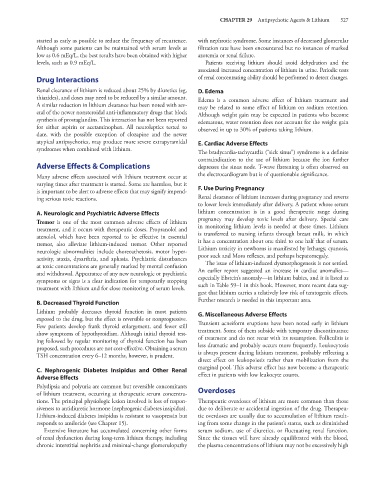Page 541 - Basic _ Clinical Pharmacology ( PDFDrive )
P. 541
CHAPTER 29 Antipsychotic Agents & Lithium 527
started as early as possible to reduce the frequency of recurrence. with nephrotic syndrome. Some instances of decreased glomerular
Although some patients can be maintained with serum levels as filtration rate have been encountered but no instances of marked
low as 0.6 mEq/L, the best results have been obtained with higher azotemia or renal failure.
levels, such as 0.9 mEq/L. Patients receiving lithium should avoid dehydration and the
associated increased concentration of lithium in urine. Periodic tests
Drug Interactions of renal concentrating ability should be performed to detect changes.
Renal clearance of lithium is reduced about 25% by diuretics (eg, D. Edema
thiazides), and doses may need to be reduced by a similar amount. Edema is a common adverse effect of lithium treatment and
A similar reduction in lithium clearance has been noted with sev- may be related to some effect of lithium on sodium retention.
eral of the newer nonsteroidal anti-inflammatory drugs that block Although weight gain may be expected in patients who become
synthesis of prostaglandins. This interaction has not been reported edematous, water retention does not account for the weight gain
for either aspirin or acetaminophen. All neuroleptics tested to observed in up to 30% of patients taking lithium.
date, with the possible exception of clozapine and the newer
atypical antipsychotics, may produce more severe extrapyramidal E. Cardiac Adverse Effects
syndromes when combined with lithium.
The bradycardia-tachycardia (“sick sinus”) syndrome is a definite
contraindication to the use of lithium because the ion further
Adverse Effects & Complications depresses the sinus node. T-wave flattening is often observed on
Many adverse effects associated with lithium treatment occur at the electrocardiogram but is of questionable significance.
varying times after treatment is started. Some are harmless, but it
is important to be alert to adverse effects that may signify impend- F. Use During Pregnancy
ing serious toxic reactions. Renal clearance of lithium increases during pregnancy and reverts
to lower levels immediately after delivery. A patient whose serum
A. Neurologic and Psychiatric Adverse Effects lithium concentration is in a good therapeutic range during
Tremor is one of the most common adverse effects of lithium pregnancy may develop toxic levels after delivery. Special care
treatment, and it occurs with therapeutic doses. Propranolol and in monitoring lithium levels is needed at these times. Lithium
atenolol, which have been reported to be effective in essential is transferred to nursing infants through breast milk, in which
tremor, also alleviate lithium-induced tremor. Other reported it has a concentration about one third to one half that of serum.
neurologic abnormalities include choreoathetosis, motor hyper- Lithium toxicity in newborns is manifested by lethargy, cyanosis,
activity, ataxia, dysarthria, and aphasia. Psychiatric disturbances poor suck and Moro reflexes, and perhaps hepatomegaly.
at toxic concentrations are generally marked by mental confusion The issue of lithium-induced dysmorphogenesis is not settled.
and withdrawal. Appearance of any new neurologic or psychiatric An earlier report suggested an increase in cardiac anomalies—
symptoms or signs is a clear indication for temporarily stopping especially Ebstein’s anomaly—in lithium babies, and it is listed as
treatment with lithium and for close monitoring of serum levels. such in Table 59–1 in this book. However, more recent data sug-
gest that lithium carries a relatively low risk of teratogenic effects.
B. Decreased Thyroid Function Further research is needed in this important area.
Lithium probably decreases thyroid function in most patients G. Miscellaneous Adverse Effects
exposed to the drug, but the effect is reversible or nonprogressive.
Few patients develop frank thyroid enlargement, and fewer still Transient acneiform eruptions have been noted early in lithium
show symptoms of hypothyroidism. Although initial thyroid test- treatment. Some of them subside with temporary discontinuance
ing followed by regular monitoring of thyroid function has been of treatment and do not recur with its resumption. Folliculitis is
proposed, such procedures are not cost-effective. Obtaining a serum less dramatic and probably occurs more frequently. Leukocytosis
TSH concentration every 6–12 months, however, is prudent. is always present during lithium treatment, probably reflecting a
direct effect on leukopoiesis rather than mobilization from the
C. Nephrogenic Diabetes Insipidus and Other Renal marginal pool. This adverse effect has now become a therapeutic
Adverse Effects effect in patients with low leukocyte counts.
Polydipsia and polyuria are common but reversible concomitants Overdoses
of lithium treatment, occurring at therapeutic serum concentra-
tions. The principal physiologic lesion involved is loss of respon- Therapeutic overdoses of lithium are more common than those
siveness to antidiuretic hormone (nephrogenic diabetes insipidus). due to deliberate or accidental ingestion of the drug. Therapeu-
Lithium-induced diabetes insipidus is resistant to vasopressin but tic overdoses are usually due to accumulation of lithium result-
responds to amiloride (see Chapter 15). ing from some change in the patient’s status, such as diminished
Extensive literature has accumulated concerning other forms serum sodium, use of diuretics, or fluctuating renal function.
of renal dysfunction during long-term lithium therapy, including Since the tissues will have already equilibrated with the blood,
chronic interstitial nephritis and minimal-change glomerulopathy the plasma concentrations of lithium may not be excessively high

